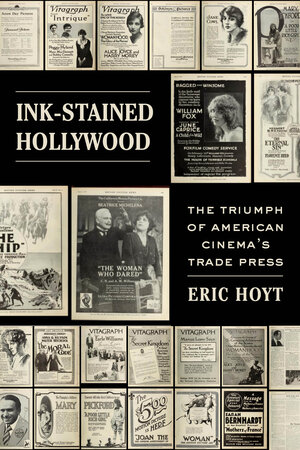The Book
Inked-Stained Hollywood
The Author(s)
Eric Hoyt

Using a theoretical framework that is equal parts Media Studies and New Cinema History, Eric Hoyt’s Inked-Stained Hollywood describes in detail the innerworkings of the film trade-journal publishing industry between the 1910s and 1930s. The book also works as a critical companion to Hoyt’s pivotal archival project The Media History Digital Library, offering important contextual information to help scholars analyze the information presented in the archived film journals.
From a scholarly perspective, Inked-Stained Hollywood covers both a broad historical period and a wide set of industry players. The film industry underwent many important changes between the 1910s and 1930s, including periods of unionization, vertical integration, the transition to sound, and the creation of the studio system (among others). The book analyzes how trade journals aligned themselves with and recorded the controversies and developments among the different sectors of the film industry (i.e., producers, distributors, exhibitors, and creatives), and how their positioning affected their business. Hoyt’s research also covers an extensive journalistic market, both in terms of geography and company size. That is, Hoyt looks in depth at both national publications as well as key regional and local ones. I found the book’s discussion of the famous/infamous Martin Quigley and the evolution of The Motion Picture Herald from a regional journal to a national one particularly enlightening.
Through his analysis of the many film trade journal players, the manuscript seeks to explain why the numerous attempts to consolidate the film trade press failed. Ultimately, Hoyt successfully demonstrates, as he seeks out to do, that the “heterogenous trade press triumphed by appealing to readers’ specific sensibilities, values, and fears” (3). That is, the book shows that the journals distinguished themselves by aligning with corporate, creatives, or exhibitors, and that particularly the latter two groups could bolster the success of a small publication or alternatively, spell doom for another.
Overall, Inked-Stained Hollywood argues that “the diversity of voices, perspectives, and expressions of language” distinguished the history and development of the film trade press from that of other industries and made it impossible for it to be successfully fused (192). More significantly for scholars who work on historical and textual analysis, Hoyt convincingly explains that the trade journals he discusses “are more than vessels for the packing and conveying of information” and that their staff often had personal, business, and creative agendas that dictated how and what they covered in their publications (196). Thus, the book reminds us to be critical of our sources even if they purport to hold journalistic objectivity.
About the Reviewer
Naida García-Crespo is an independent researcher with a PhD in English from the University of Illinois in Urbana Champaign. Her work has appeared in Film History, Early Popular Visual Culture, and CENTRO Journal, among other journals. She is the author of Early Puerto Rican Cinema and Nation Building (1897-1940): National Sentiments, Transnational Realities (Bucknell University Press, 2019).

0